|
He Helped Make Kansas The Wheat State
C. Francis Angell, Date Unknown (Source: Angell Family)
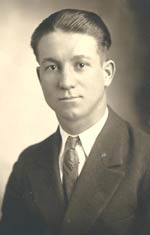 |
This page is unique and important to the Davis-Monthan Register project, because Charlie Francis Angell's biography is the 1,000th page written for this Web site since it went online in May, 2005. That's about 143 new additions to the site per year or, on average, one new entity online every 2.5 days. Please direct your browser to the "What's New on the Site?" page to see how they accrued over the past seven years.
As of the upload date of this page, there are online biographies of 444 of the PEOPLE who signed the Register, technographies describing 458 of the AIRPLANES that landed at Tucson, descriptions of 11 early aircraft manufacturing companies, depictions of 52 PLACES that pilots cited as home or destinations, and accounts of 5 significant EVENTS in which our Golden Age pilots and aircraft participated. These 1,000 are all accessible via the blue buttons at the top right of this page.
Francis Angell’s lone visit at Tucson was on December 26, 1934. He arrived in a Stinson SM-8A, register number NC247W. Please direct your browser to the link to see photographs of this airplane.
Adele Edwards Angell Holding Infant Son, Wayne D.Angell With C. Francis Angell Holding Charlie L. Angell (Source: Angell Family)
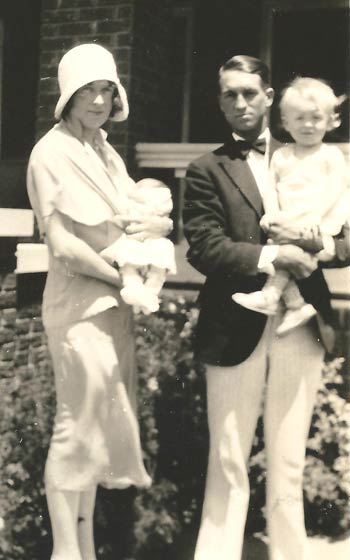 |
Although he didn't enter it in the Register, Angell and his three passengers departed from Santa Ana, CA and were headed to El Paso, TX. We know this, and who the passengers were, because Mr. Woodling (cited, right sidebar) has recently conducted interviews with two of them: Charlie and Wayne Angell, the first two sons of Francis Angell and Adele Angell, who was the third passenger. The family had traveled to California to celebrate Christmas with Mrs. Angell’s relatives.
After a delay due to morning fog at Eddie Martin airfield in Santa Ana, Francis took off and headed west over the Pacific coast to gain altitude prior to turning East to cross the mountains. They arrived at Tucson around noon, and ate lunch while the Stinson was refueled. They arrived in El Paso after sunset and spent the night there.
The family’s ultimate destination was Plains, KS, where Francis owned a wheat farm. He was a descendant of emigrants from North Carolina, who journeyed west on the Santa Fe Trail to homestead in western Kansas.
His father, C.J. Angell, was a wheat farmer and inventor who devised a plow that revolutionized farming in western Kansas. With the help of Francis, C.J. perfected the plow and built several hundred of them before selling the rights to The Ohio Cultivator Company (see the brochure further down the page).. Below, C.J. Angell waist high in a wheat field his plow no doubt prepared.
Charlie Francis Angellís Father, C.J. Angell, Who Invented The Angell One-Way Plow (Source:Web)
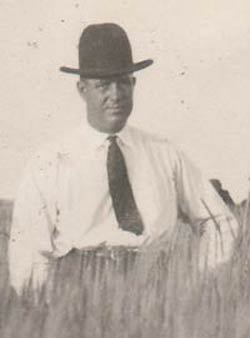 |
Francis began his flying career in 1931 when he bought a Travel Air 2000, registration number NC9978 (not a Register airplane), from Mr. Morse, who then taught Francis how to fly the airplane. By 1934 he had accumulated 60 hours in the Travel Air.
The Travel Air was too small to fly the entire family to California, so Francis drove them in his 1934 Chrysler Airflow. According to Charlie Angell, his father did not particularly like the Chrysler and was looking for an opportunity to get rid of it. Opportunity knocked while Francis was hanging out at a local airport in California that December. He struck up a conversation with the owner of NC247W, who apparently no longer wanted the Stinson. Charlie offered him the Chrysler in trade for the airplane and a deal was struck.
Below is a photograph of the 1928 Travel Air that was Angell's first airplane; too small to carry all of his family. As well, it was probably not a good idea to carry infants in the wind and noise of the open airplane.
1928 Travel Air NC9978, OX5 Engine (Source: Angell Family)
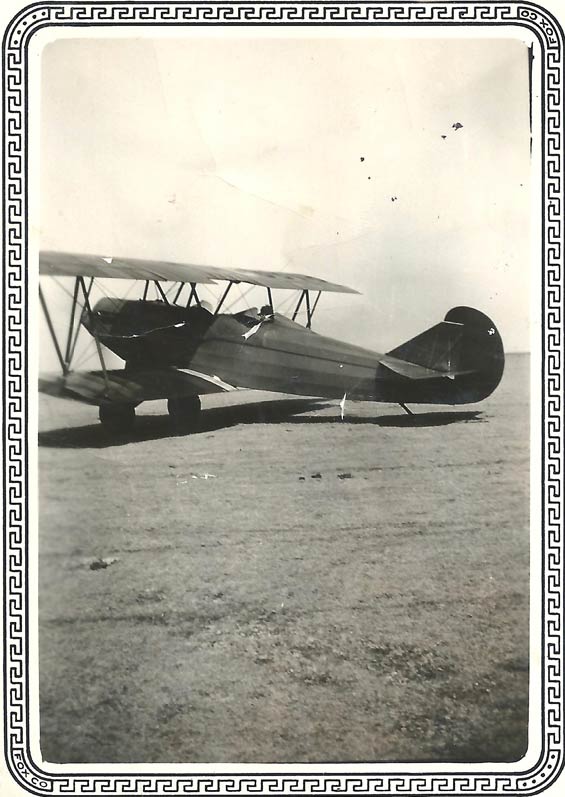 |
Below is a magazine advertisement for the 1935 Airflow Chrysler that was disliked by pilot Angell and traded for the Stinson. Note the identification of "overdrive" as a major advancement in comfort and fuel economy.
Advertisement, Airflow Chrysler, 1935 (Source: Web)
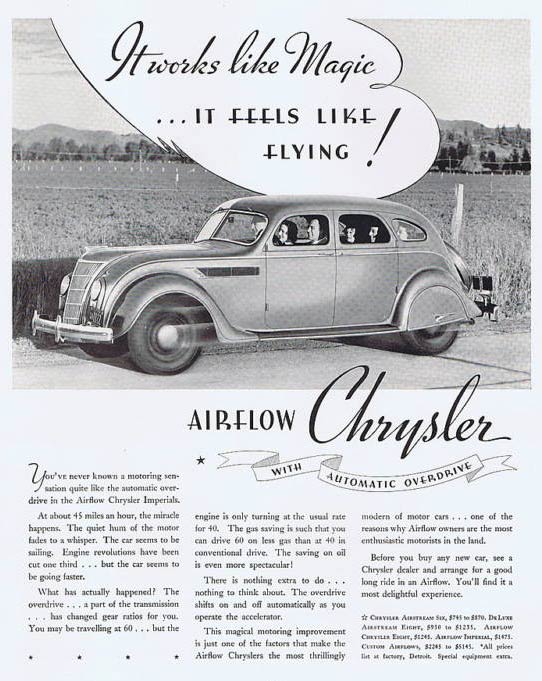 |
Below, a photograph of NC247W at Daugherty Field near the time it was purchased by Angell.
Stinson SM8A NC247W at Daugherty Field, Long Beach, California in 1933 (Source: Web)
 |
Without the Airflow, the family flew back to Kansas in the Stinson. In preparation for the transfer, the page from Angell's log book below documents his claim that he logged 60 hours of flight time.
Francis Angellís Certification That He Had Accumulated 60 Hours of Solo Time by December 17, 1934 For the Purchase of the Stinson N247W (Source: Angell Family)
 |
The second and third pages of Francis’ logbook shown below document the first month of his flying in the Stinson. The first several flights on page 2 appear to be familiarization flights in the local Southern California area. Page 3 documents the flight segments from Santa Ana to Plains. On December 26, 1934, the family departed Santa Ana from Eddie Martin Airport, which was near the current John Wayne airport.
This Page Documents The Flying Time Accumulated In The Stinson Prior To The Flight To Plains, KS (Source: Angell Family)
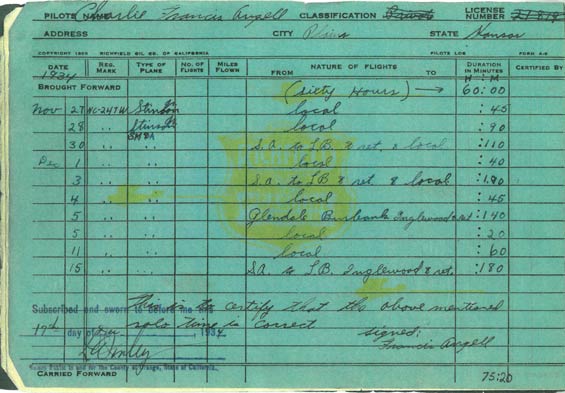 |
The route to Plains included stops in Tucson and El Paso, below, where the family stayed overnight. Interestingly, Francis did not enter the landing in Tucson on December 26th.
The Familyís Flight To Plains, KS Is Documented On This Page (Source: Angell Family)
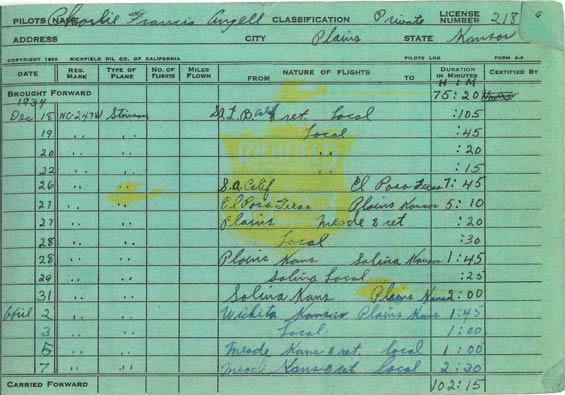 |
The hiatus in the logbook immediately after December 31st was a result of the airplane being out of service for three months while it was being repaired after an accident. On a trip from Salina to Plains that day, Francis made an unscheduled landing near Dodge City to allow one of the passengers to step out of the airplane for a bathroom break. While on the ground, a wind gust flipped the airplane over a barbed wire fence and onto its back.
Francis and his passengers found their way back to Plains, after which he returned to the accident site with his flatbed truck, onto which he loaded the wings and fuselage. He then transported the disassembled airplane parts to Wichita, where the Cessna airplane company repaired the airplane. Many years later, Wayne Angell was told by Cessna’s Dwane Wallace that repairing the Stinson was welcome work for the factory, which was suffering through the Great Depression in 1934.
A few years earlier, when his family was younger, Francis posed in front of an Auburn convertible coupe given to him by his dad in 1927. Charlie Leon, around 7-months, is in his dad's arms. The car behind is the 4-door Stutz Bearcat that was C.J.'s last car, probably a 1926 or 1927.
Auburn Convertible Coupe Given To Francis By His Dad In 1927 (Source: Angell Family)
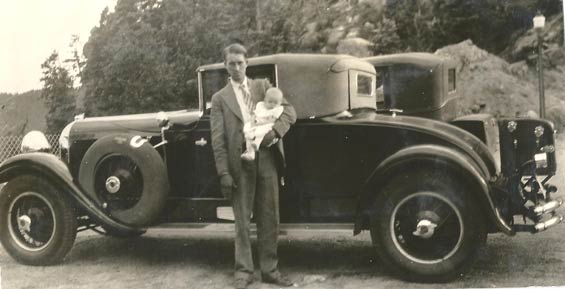 |
Below, a similar photograph with Mrs. Angell holding Charlie Leon.
Mrs. Angell with Charlie Leon, Ca. 1927 (Source: Angell Family)
 |
Below, Francis Angell stands with the family invention, the Angell one-way disc plow. From the looks of the cars, this photo was taken sometime in the 1960s.
Francis Angell Standing Next To The Famous Angell Plow In Plains, KS (Source: Angell Family)
 |
Below, a manufacturer's brochure advertising the virtues of the one-way disc plow. A major feature, besides preparing the soil appropriately, was the preservation of wheat stubble as a mulch to prevent wind erosion.
Sales Brochure For The Plow Invented By C.J. Angell (Source: Angell Family)
 |
Below, the plow working as it was designed. It appears this is the photo was taken at the same time as the one in the brochure above. The photos are not identical, but close.
The Angell Plow In Action (Source: Angell Family)
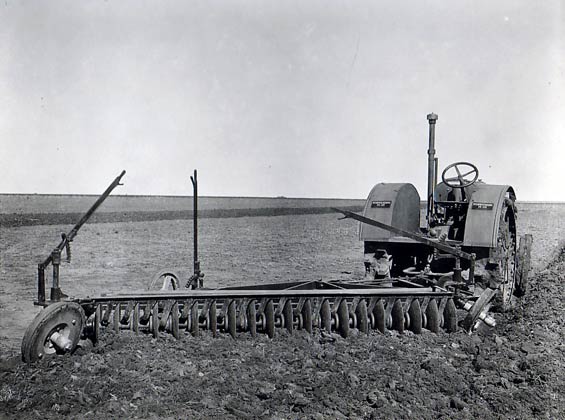 |
Below, the Angell's home in Plains, KS as it stood about the time he visited Tucson.
The Angellís Farmhouse And Barn, Plains, KS (Source: Angell Family)
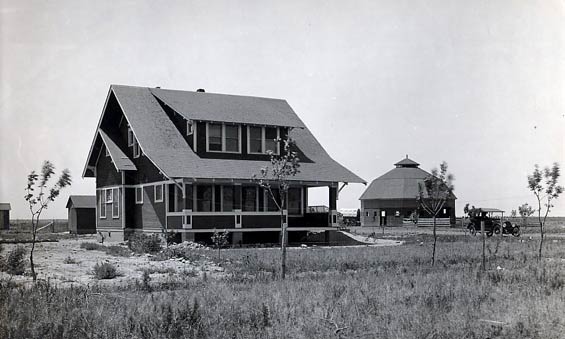 |
To continue with Angell and his flying career, after the Stinson was repaired, Francis used the airplane for many purposes, one of which was to demonstrate an airplane’s utility in delivering airmail to small towns. Shown here during National Air Mail Week in 1938, Francis delivers sacks of airmail to a local postmaster, with the silver and red Stinson in the background.
Charlie Angell With Airmail Sacks And Unidentified Man. Stinson SM8A NC247W In Background; Ca.1938 (Source: Angell Family)
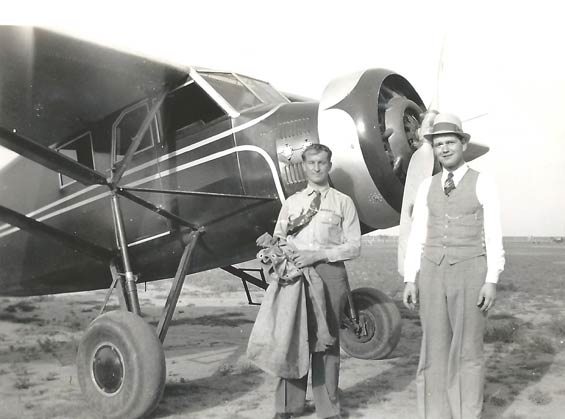 |
Over the following years Francis owned several airplanes including a 65hp Taylorcraft, a Stinson SR6, an Aeronca Chief, a Waco UME, a Stinson Voyager, a Luscombe 8A and a Stinson 150. According to his sons, Francis was an avid racer and flew in pylon races in county fairs in western Kansas. In 1947 Flying Magazine called him the granddaddy of flying farmers.
Francis Angellís Airmanís ID Card, August 15, 1951 (Source: Angell Family)
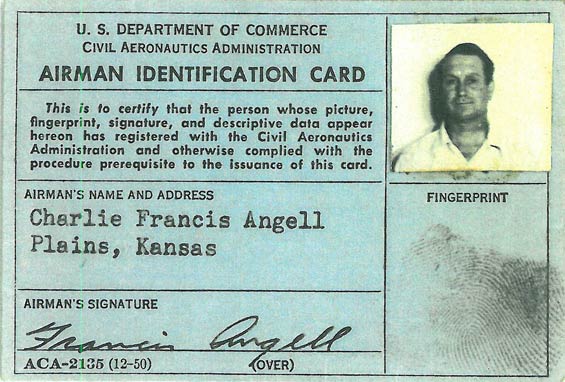 |
He was also a certificated pilot examiner as identified below.
Francis Angellís Instructor License, March 4, 1947 (Source: Angell Family)
 |
Below, a scene at Dodge City, KS probably taken in the 1940s. From tail forward: Hank Gould; Chuck Barhydt; Anderson (from Iowa); Harold Kennedy; Jay O. Borth; Jim Mahon (Effingham, IL); Francis Angell; Jack Ridpath; Benson (Iola, KS); Ray Romaine or Romine; standing are Roy and Maxine Mahon. The airplane is a Timm PT-160K Aeromold trainer. The building in the background is still in use today as Dodge City’s airline terminal.
Students And Instructors At Dodge City, KS (Source: Angell Family)
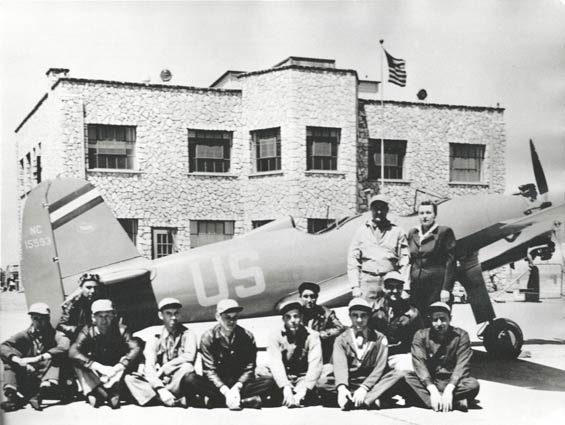 |
Below, instructor Angell with others. The airplane behind the three was a Franklin 65 hp powered Porterfield that was their main training airplane.
L To R: Jay Borth, Francis Angell, And Hank Gould At Dodge City, KS Airport (Source: Angell Family)
 |
Angell was a charter member of the Kansas Flying Farmers, he was Squadron Commander of the Plains Civil Air Patrol (CAP), participated in several All- Kansas Air Tours, and assisted in the formation and construction of the Plains Airport in 1941-1942. Below, his CAP identification.
Civil Air Patrol ID Badge, July 5, 1952 (Source: Angell Family)
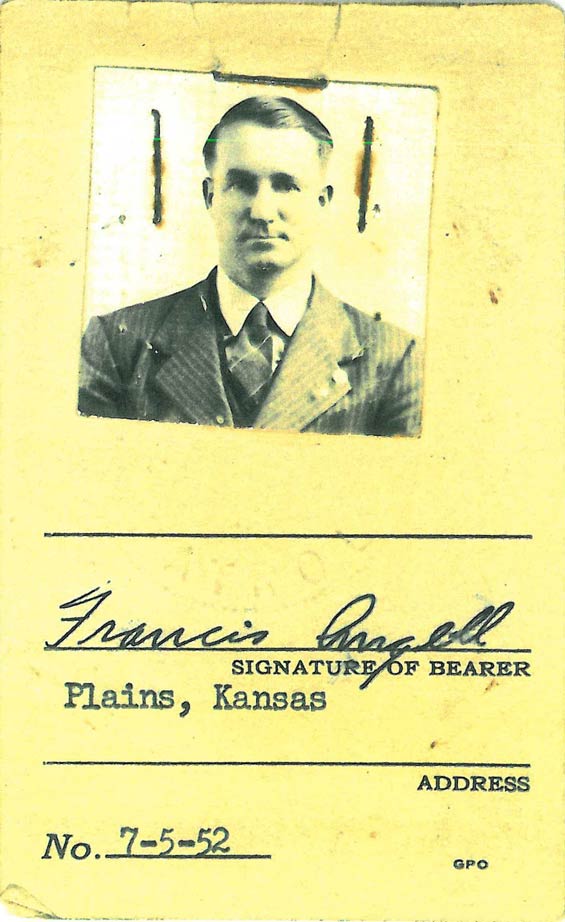 |
Below, Angell in the CAP.
Francis Angell, Civil Air Patrol (Source: Angell Family)
 |
Angell served during World War II, in 1942, as a civilian flight instructor for the Army and was stationed at Dodge City and Topeka. He taught many persons in western Kansas to fly including two of his sons, Charlie and Wayne.
Charlie Angell passed away in November, 1974 at age 66. The following tribute to Francis and his father was printed in the Topeka State Journal in December, 1974.
Helped Make This The Wheat State
One of the principal factors keeping Kansas the No. 1 wheat state of the nation is the great producing area in the western one-third of the state. Much of the rich yield of hard, red winter wheat from this area comes from acres developed from grassland to cropland in the 1920s. One of the men whose ideas and techniques helped bring this about died early this week. He was Francis Angell of Plains, who for half a century farmed in that area. Working with his father, Charlie J. Angell, he developed the one-way disk plow and led the way in its manufacture. Hundreds of these plows were built on the Angell farm near Plains in the mid-1920s. The plow made summer-fallowing practical and. economical for the first time. Three of these plows, are now on display at the Kansas Historical Society in Topeka, the Agricultural Hall of Fame at Bonner Springs and in the Smithsonian Institution at Washington, D.C. Francis Angell's name must be inscribed along with those of others who pioneered the way that has made and is keeping Kansas an important segment in the great food production of the United States and the world.
|
---o0o---
THIS PAGE UPLOADED: 07/09/12 REVISED:
|























